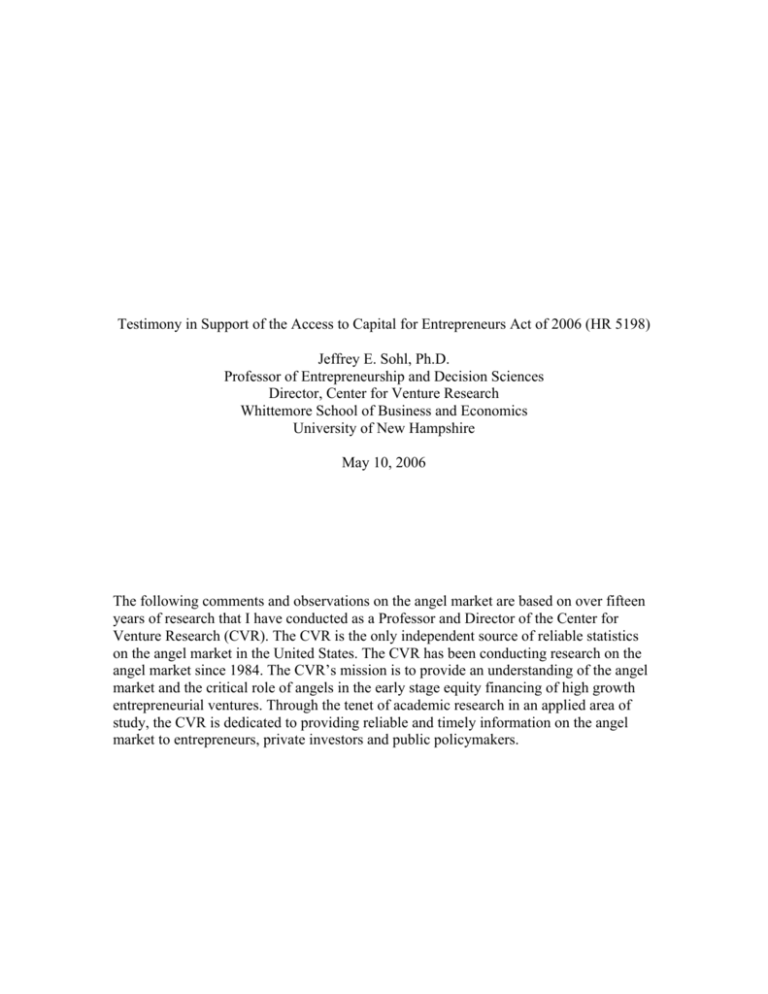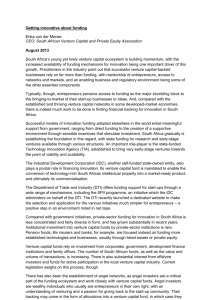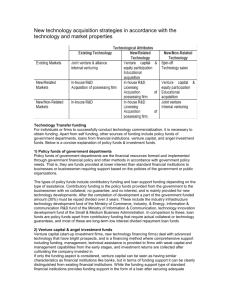Testimony in Support of the Access to Capital for Entrepreneurs Act
advertisement

Testimony in Support of the Access to Capital for Entrepreneurs Act of 2006 (HR 5198) Jeffrey E. Sohl, Ph.D. Professor of Entrepreneurship and Decision Sciences Director, Center for Venture Research Whittemore School of Business and Economics University of New Hampshire May 10, 2006 The following comments and observations on the angel market are based on over fifteen years of research that I have conducted as a Professor and Director of the Center for Venture Research (CVR). The CVR is the only independent source of reliable statistics on the angel market in the United States. The CVR has been conducting research on the angel market since 1984. The CVR’s mission is to provide an understanding of the angel market and the critical role of angels in the early stage equity financing of high growth entrepreneurial ventures. Through the tenet of academic research in an applied area of study, the CVR is dedicated to providing reliable and timely information on the angel market to entrepreneurs, private investors and public policymakers. In 1874, a young Alexander Graham Bell was searching for money to complete his early experiments on the telephone. Most investors adopted the prevailing opinion as summarized in an editorial in the Boston Post “well-informed people know it is impossible to transmit the voice over wires and that were it possible to do so, the thing would be of no practical value.” Besides, Mr. Bell did not have a company with any tangible assets to provide collateral. Recognizing an opportunity, Boston attorney Gardiner Green Hubbard and leather merchant Thomas Sanders of Salem, Massachusetts put up the equity capital to start the Bell Telephone Company of Boston (Sohl, 2003). The rest is history. Fast forward 100 years to witness perhaps one of the most lucrative angel deals, when in 1976 Anita Roddich needed capital to open a second store. Her bank responded that she had only been in business a few months, she had no track record and that she should wait another year. Ms. Roddich turned to a private investor, Ian McGlinn, who invested the 4000 pounds sterling she needed. She opened that second store and so began the development of the Body Shop, a corporation with over 700 stores today. From telephones to cosmetic stores, the angels progressed into the internet when in 1994 Jeff Bezos and a few employees created a web site and database in Bezos’ Bellevue, Washington garage. He went looking for capital from venture capital firms but their response became a familiar one: good idea but, well, maybe later. After being introduced to some private investors, he succeeded in raising $1.2 million from a dozen private investors. A later round of $8 million was provided from professional venture capital funds. In May, 1997 the company, Amazon.com, completed an initial public offering, providing the investors and entrepreneurs with a handsome return (Sohl, 1999). These humble beginnings of the angel market provided the motivation for research on the early stage equity financing of entrepreneurial ventures. Beginning in 1984, with the seminal work on business angels conducted by William Wetzel (1983), the Center for Venture Research has been collecting and analyzing data on the angel market. Although angel investors have been in existence for many years, they are in many ways our nation’s least understood, and most underutilized, economic resource. Quietly providing the majority of the seed and start-up capital for high tech entrepreneurial ventures, the angel market of today faces some significant challenges. The angel market is in constant flux, and the recent volatility of the private equity market has only provided additional motivation to understand the role of these critical early stage investors and to facilitate their investment activity. The entrepreneurial economy and its contribution to economic growth and job creation in the United States has been well noted in both the academic literature and by various government agencies. High growth entrepreneurial ventures hold the greatest potential for innovation, commercialization of technology and sustainable economic development. However, entrepreneurial ventures face significant financial hurdles in the early stage of their development (Sohl, forthcoming; Amatucci and Sohl, forthcoming). Unable to attract debt capital in the early stage, and the mismatch between the need for growth capital and the short term financial requirements of debt financing, contributes to the importance of equity financing. This critical role of early stage equity financing throughout the history of the entrepreneurial economy has been well documented (Wetzel 1986, Ou 1987, Gaston and Bell 1988, Mason and Harrison 1992). 2 Angels (private investors) are the oldest and largest source of seed and start-up capital for entrepreneurs. In the United States angels invest more dollars in more companies than the formal, or institutional, venture capital market. In 2005, in the United States, angels invested $23.1 billion in 49,500 ventures, or approximately $470,000 per deal (Center for Venture Research 2005). In contrast, during this same time period venture capital funds invested $22.1 billion in 3,008 deals, for an average of $7.4 million per deal. In the seed and start-up stage, the difference between angels and venture capitalists is even more stark. Close to 55% of angel deals in 2005 were in the seed and start-up stage, while venture capitalists allocated a mere 6% of the deals to these stages. Even during the best of times venture capitalists, over the last decade, have never invested more than 15% of the deals in the seed and start-up stage. As such, angels and venture capitalists occupy unique spaces in the spectrum of providers of risk capital. Angels invest smaller amounts per investment and are the seed engine for entrepreneurs, while venture capitalists invest in larger deals in the later stages of growth. The majority of these angel deals are in the critical seed and start-up stage. In spite of the volume of angel investing, the early stage equity market is fraught with inefficiencies. For the firm with an established financial record and tangible assets, financial markets supply an extensive assortment of financing instruments, with these markets being relatively accessible and the owner is left to decide the optimum mix of a financial structure based on the cost of capital. For the high growth entrepreneurial firm, this supply assumption may not hold, causing systematic market mismatches at particular stages of development of the fast growth firm (Brophy 1997). These imperfections, most notably in the informal venture capital market, are well documented (Freear, Sohl and Wetzel 1994a; Harrison and Mason 1993; Landstrom 1993; Mason and Harrison 1992; Gaston 1989; Riding and Short 1987). Market imperfections lead to market inefficiencies. While the need for early stage angel capital exists, inefficiencies in the private equity market are manifested by two substantial capital gaps: a primary seed stage gap and a secondary post-seed gap (Sohl 2003). The primary seed stage gap is a capital and information gap between the needs of early stage ventures and the suppliers of early stage capital, in part due to an inadequate supply of patient, high-risk value-added equity capital (Sohl and Wetzel 1996). Information inadequacies are the byproduct of the inherent inefficiency of the angel market. An efficient market implies an open and timely flow of reliable information concerning financing sources and investment opportunities. In the informal venture capital market, with the suppliers of capital seeking a degree of anonymity consistent with the need to maintain reasonable deal flow, information flows very inefficiently (Freear, Sohl and Wetzel 1994b; Mason and Harrison 1996). This capital and information inefficiency results in the primary seed stage gap. This primary funding gap occurs in the seed and start-up financing stage and ranges from $100,000 to $2 million. While this is the main area in which angels operate, both the difficulty in finding angels and the lack of “investor ready” quality deals, combined with an inadequate supply of capital, results in a substantial funding gap. 3 The second funding gap, the secondary post-seed gap, occurs in the $2 to $5 million range (Sohl, 1999). These larger capital requirements have traditionally been considered too large for angel investors and, as the venture capital industry migrates to later stage and larger deal size, are deemed too small for venture capitalists. Recent research indicates that angels are increasing their investments in this $2 to $5 million range as market conditions require angels to provide some follow-on financing for their investments (Center for Venture Research 2004, 2005). However, this movement by angels to second stage financing is a redistribution of risk capital and as such, exacerbates the capital gap in the seed and start-up stage. It is in this critical seed stage funding gap where tax incentives can be most effective. Seed and start-up stage investors face substantial risk due to the uncertainty of concept development into a commercially feasible product, the uncertainty of market acceptance, the scalability of the venture, information asymmetries and the inefficiency inherent in seed and start-up stage investing. A tax credit at the time of the seed investment provides the entrepreneur with capital exactly when it is needed, during product and firm development. In addition, the Access to Capital for Entrepreneurs Act of 2006 affords the angel investor with a degree of downside risk protection and the tax credit could well transform the risk/reward equation into one with an acceptable level of investment and return that is commensurate with the risk of early stage equity investing. It should be noted that previous research conducted by Jeffrey E. Sohl and the Center for Venture Research indicates that a reduction in the capital gains tax (a tax savings realization at the time of exit) appears to not be a favorable tax incentive. In essence, the venture needs to survive the critical seed stage and expand into a viable business with reasonable market share before an exit (merger, acquisition or initial public offering) can take place. As such, a capital gains reduction, which occurs at the exit event, is only realized if the venture survives the seed stage. Thus, the proper tax incentive program is one that is targeted at the “front end” during the start-up stage, when the risk of failure is the greatest and the capital gap is the most severe. The tax credit proposed in HR 5198 is a judicious use of public policy since it targets the incentive at exactly the time it is needed by both the entrepreneur and the angel investor. For the entrepreneur HR 5198 increases the potential for securing seed capital and for the investor the act indirectly provides a slight reduction in the risk of seed stage investing. For the entrepreneurial economy HR 5198 mitigates, in part, the primary seed stage capital gap. While HR 1598 will not solve all the difficulties facing the entrepreneur in securing critical seed stage equity capital, I applaud the efforts of Representatives Manzullo and Pomeroy for this important first step in facilitating the growth of the entrepreneurial economy and increasing the potential to move innovation from the laboratory to the marketplace. 4 Amatucci, F. and J. Sohl, forthcoming, “Trends in the Angel Market”, Entrepreneurship, Volume II: The Process, A. Zacharakis and S. Spinelli, eds., Praeger Perspectives. Brophy, D.J. (1997), ‘Financing the growth of entrepreneurial firms’, in D. Sexton and R. Smilor (eds), Entrepreneurship 2000, Chicago, IL: Upstart Publishing, pp. 5-27. Center for Venture Research (2004) ‘The angel investor market in 2003: The angel market rebounds, but a troublesome post seed funding gap deepens’ http://wsbe.unh.edu/Centers_CVR/2003AR.cfm, 21 April. Center for Venture Research (2005) ‘The angel investor market in 2004: The angel market sustains a modest recovery’ http://wsbe.unh.edu/Centers_CVR/2004analysisreport.cfm, 22 March. Freear, J., J.E. Sohl and W.E. Wetzel, Jr. (1994a), ‘The private investor market for venture capital’, The Financier, 1 (2), 7-15. Freear, J., J.E. Sohl and W.E. Wetzel, Jr. (1994b), ‘Angels and non-Angels: are there differences?’, Journal of Business Venturing, 9 (2), 109-123. Gaston, R.J. (1989), Finding Private Venture Capital for your Firm: A Complete Guide, New York, NY: John Wiley and Sons. Gaston, R.J. and S.E. Bell (1988), ‘The informal supply of capital’, Office of Economic Research, U.S. Small Business Administration, Washington, D.C. Harrison, R.T. and C.M. Mason (1993), ‘Financing for the growing business: The role of informal investment’, National Westminster Quarterly Review, May, 17-29. Landstrom, H. (1993), ‘Informal risk capital in Sweden and some international comparisons’, Journal of Business Venturing, 8, 525-540. Mason, C.M. and R.T. Harrison (1992), ‘The supply of equity finance in the UK: A strategy for closing the equity gap’, Entrepreneurship and Regional Development, 4, 357380. Mason, C.M. and R.T. Harrison (1996), ‘Informal venture capital: a study of the investment process and post-investment experience’, Entrepreneurship & Regional Development, 8 (2), 105-126. Ou, C. (1987), ‘Holdings of privately-held business assets by American families: findings from the 1983 consumer finance survey’, unpublished report, Office of Economic Research, U.S. Small Business Administration, Washington, D.C. 5 Riding, A. and D. Short (1987), ‘Some investor and entrepreneur perspectives on the informal market for risk capital’, Journal of Small Business and Entrepreneurship, 5, 1930. Sohl, J.E., 1999, “The Early Stage Equity Market in the United States”, Venture Capital: An International Journal of Entrepreneurial Finance, Vol. 1, No. 2, pgs. 101-120. Sohl, J.E., 2003, “Angel investing: a market perspective”, in State of the Art: An Executive Briefing on Cutting Edge Practices in American Angel Investing, J. May and E. O’Halloran, eds., Darden Business Publishing, Charlottesville, VA, pgs. 2-14. Sohl, J.E., forthcoming “The Organization of the Informal Venture Capital Market”, Handbook of Research on Venture Capital, Hans Landstrom ed., Edward Elgar Publishers. Sohl, J. and W.E. Wetzel, Jr. (1996), ‘Creating New Capital Markets for Emerging Ventures’, Report # SBAHQ-95-M-1062 for the US Small Business Administration, Washington, DC. Wetzel, W.E., 1983, Angels and Informal Risk Capital. Sloan Management Review, 24: 23-34 Wetzel, W.E., Jr. (1986), ‘Informal risk capital: knowns and unknown’, in D.L. Sexton and R.W. Smilor (eds), The Art and Science of Entrepreneurship, Cambridge: Ballinger, pp. 85-108. 6







